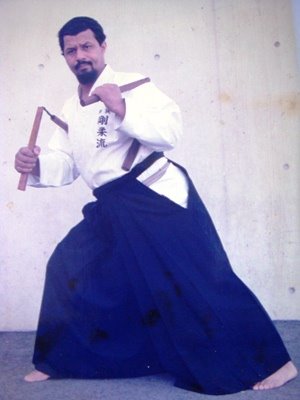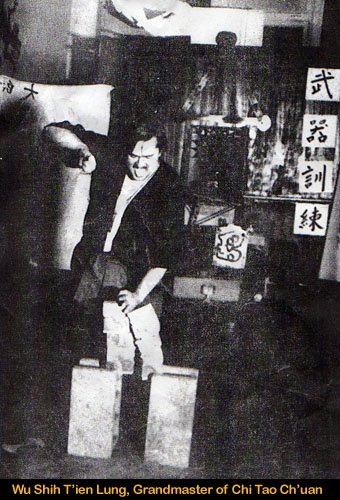
I begin this entry with a bit of sadness, I learned of the death of my good friend Natambu Camera Bomani Shihan who allowed me the honor of working out in his dojo when I lived in Dar Es Salaam, Tanzania in the mid-1970s. He died in Ghana last summer of a massive heart attack.
I had been in touch with him over the past few years after not speaking to him for over 20 years. Bomani taught two generations of martial artists in Dar, the school is still thriving. Bomani taught members of Umkonto wa Sizwe, the military arm of the African National Congress. Through Bomani I was able to meet many of the young men who had gone into exile to fight against the South African apartheid regime in the 1970s.
“Mr. Bomani began his martial arts training in Africa in the 1906s. By 1968, Mr. Bomani, had traveled to Okinawa and began training with Eiichi Miyazato Sensei at the Jundokan. Mr. Bomani was a student of Miyazato Sensei’s, until Miyazato Sensei passed away in 1999. Since that time he has trained under Koshin Iha Sensei. Mr. Bomani was responsible for introducing Jundokan Gojuryu to Tanzania and he founded the Tanzania Okinawa Gojuryu Karate Association. Mr. Bomani was also instrumental in spreading Jundokan Gojuryu through out the United States. He founded many dojos in New York, Washington,Kentucky and Ohio. He has left several yudansha spread across the United States and Africa.”
After not being in touch with Bomani for over 20 years I finally tracked him down and we were to meet this Spring as he was leaving the country for awhile. His son called me last week to let me know he had past, he found one of my messages and realized I was not aware of his passing. Sensei Bomani, though our time together was brief, had a get effect on me. I was surprised his son knew of me and said his father had spoken of me many times. Bomani gave me a way of looking at Africa, past the bullshit, past the vagaries of expatriatism. He showed me how to blend, and communicate with people in a place foreign to me. So it was not foreign to me for long. Knowing him, people took time to know me.
He walked among the common people of Tanzania with respect and love, having married a Tanzanian woman and living in the community instead of the usual expatriate abodes, separate and apart from the real community. He lived with his wife in a simple 2 room dwelling and she cooked on a a small charcoal stove, fresh whole wheat chapati, he was vegetarian and we had that in common. Dar Es Salaam was the easiest African city I have ever been in to be vegetarian. I  was hard core back then. Bomani and his wife’s extended family taught me how to live like a Tanzanian, away from the restaurants in hotels so many many of my fellow African American expat acquaintance frequented. There was a strong indian presence in Tanzania so I could get dal and puri and whatever veg Indian cuisine I desired back then.
was hard core back then. Bomani and his wife’s extended family taught me how to live like a Tanzanian, away from the restaurants in hotels so many many of my fellow African American expat acquaintance frequented. There was a strong indian presence in Tanzania so I could get dal and puri and whatever veg Indian cuisine I desired back then.
I remember being to his house for dinner many times and a chorus of frogs outside his window during dinner, so loud we could hardly hear sometimes. Chapati and Spinach curry, coconut rice, with fresh baked chapati on a charcoal stove. I learned to make the coconut rice, from a whole coconut, shredding the meat and socking it, making coconut milk.
I remember making the long trek from his home back to the Chicken Farm, where i was staying at the time. I took the last bus and my two mile walk in the dark on a side road outside Dar, re-examining parts of our conversations about identity, nationality, struggle, mission, purpose, and quantifiable results. It was a good time in Dar Es Salaam, the times of Tanzania’s first President Mwalimu Julius. Nyerere. We would see him on the beach some mornings when we did sunrise workouts. President Nyerere would wave, alone walking in solitude like he had not a care in the world. Certainly the Moranguzi (Secret Service)was not too far away. 
I almost drowned one afternoon workout when I walked far out into the sand to the pictures and the tide of the Indian Oceans started coming in. When I got to shore the water had almost been up to my shoulders and I was trying to save my cameras. Bomani did warn me when I walked out there. He said he figured I would eventually float back to shore one way or another.
He had hundreds of students. I remember the 5 mile runs in formation. Bomani always leading. He was a hard taskmaster. A good friend in the short time I was there. I think we both had malaria at the same time. I left Dar for awhile after that, as my recovery was good but I was having some strange recurrences. I really looked forward to our meeting this Spring. I am really sad about this.
Preparing to Shoot in April and May
Been a long time since I blogged because of a plague of internet trolls who want to harrass me into telling this story, their way. Some good things have happened and I will most likely be finished this year. I won’t talk much about the good thing because I am adamant about protecting all my sources from any internet harassment and threats that might come from the people who slander me and the project online.
I have a dilemma with the reenactment of the dojo war. While a lot of people think this is a “cool” event, I have to remind myself that someone died. I avoided even wanting to do it for a long time and I kept coming back to it because of the nature of the vent, the time, and it’s historical resonance. Now, a lot of that is bullshit in the face of Jim Konsevic dying. I have to answer to the people who were alive during that era, people whom I respect greatly. Before I do it I have to speak once again to one of Jim’s surviving relatives. If he is not down with it, I will have to figure something out that I can live with.
I guess I am just not mercenary enough to do it without getting a full understanding of what I am doing and having to respect the impact it had on the people who survive it’s memory. The question is how to do it so it is not romanticizing, or sensationalistic, glorifying this tragic event.
It clearly happened and it was 40 years ago this month. I have it planned, I have actors in place, a location in mind. I still have not got an on-screen interview with one of the Green Dragon Society leadership. I have to have these voices to get some clarity and balance in telling the story.

Head of the Green Dragon Society, Douglas Nowokunski, died this past month. He had reached out to me letting me know where he was in that mysterious way so prevalent with a secret society. I have to make a new approach to surviving members, who by now understand I am not taking sides, but seeking clarity to how the tragedy came about so we can finally lay it to rest.
In a pure documentary sense, as I get closer to shooting I have to ask myself these questions and make sure my motivations are sound and give it the sense of tragedy that the event really entails.
I have one person who was there so far whose story I was able to do some comparison with the police report, which has it’s own problems. 40 years is a long time. I won’t “get it right.” Memories fade, the court record is incomplete, people are still scared, it was a homicide that was dismissed with a lawyer,
Robert Cooley, who has admitted to buying off judges during his career.
People who were active in the martial arts during the 1960s and 70s are always asking me why I am bothering to do this. There is still some apprehension regarding Keehan/Dante.
Everything else about the film is easy.
Young people are fascinated with the stories of Dante. I am constantly surprised at how often there are new entries and blog posts about Count Dante that are independent of knowledge of my film project. There is an urban legend here that goes from Chicago inot the marvel comics universe, boxing and men’s magazines, to France, England, Russia and even Madagascar.
But I am weary, anxious to complete, so I can do move onto another project next year. I am certain that this will be a popular underground project, people are anxious for me to finish, I am anxious, time for the big push. Let’s get it onnnnnnnn.
 was hard core back then. Bomani and his wife’s extended family taught me how to live like a Tanzanian, away from the restaurants in hotels so many many of my fellow African American expat acquaintance frequented. There was a strong indian presence in Tanzania so I could get dal and puri and whatever veg Indian cuisine I desired back then.
was hard core back then. Bomani and his wife’s extended family taught me how to live like a Tanzanian, away from the restaurants in hotels so many many of my fellow African American expat acquaintance frequented. There was a strong indian presence in Tanzania so I could get dal and puri and whatever veg Indian cuisine I desired back then.


